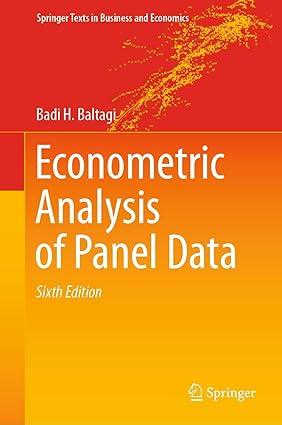Measurement error and panel data. This problem is based upon Griliches and Hausman (1986). Using the simple
Question:
Measurement error and panel data. This problem is based upon Griliches and Hausman (1986). Using the simple regression given in (10.1)-(10.3):
(a) Show that for the first-difference (FD) estimator of \(\beta\), the expression in (10.8) reduces to
\[\operatorname{plim} \widehat{\beta}_{F D}=\beta\left(1-\frac{2 \sigma_{\eta}^{2}}{\operatorname{var}(\Delta x)}\right)\]
where \(\Delta x_{i t}=x_{i t}-x_{i, t-1}\).
(b) Also show that (10.8) reduces to
\[\operatorname{plim} \widetilde{\beta}_{W}=\beta\left(1-\frac{T-1}{T} \frac{\sigma_{\eta}^{2}}{\operatorname{var}(\tilde{x})}\right)\]
where \(\widetilde{\beta}_{W}\) denotes the Within estimator and \(\tilde{x}_{i t}=x_{i t}-\bar{x}_{i}\).
(c) For most economic series, the \(x_{i t}^{*}\) are positively serially correlated exhibiting a declining correlogram, with
\[\operatorname{var}(\Delta x)<\frac{2 T}{T-1} \operatorname{var}(\widetilde{x}) \text { for } T>2\]
Using this result, conclude that
\[\left|\operatorname{bias} \widehat{\beta}_{F D}\right|>\left|\operatorname{bias} \widetilde{\beta}_{W}\right|\]
(d) Solve the expressions in parts (a) and (b) for \(\beta\) and \(\sigma_{\eta}^{2}\) and verify that the expressions in (10.9) and (10.10) reduce to
\[\begin{aligned}
\widehat{\beta} & =\frac{\left[2 \widetilde{\beta}_{W} / \operatorname{var}(\Delta x)-(T-1) \widehat{\beta}_{F D} / T \operatorname{var}(\tilde{x})\right]}{[2 / \operatorname{var}(\Delta x)-(T-1) / T \operatorname{var}(\tilde{x})]} \\
\sigma_{\eta}^{2} & =\left(\widehat{\beta}-\widehat{\beta}_{F D}\right)
\operatorname{var}(\Delta x) / 2 \widehat{\beta}
\end{aligned}\]
(e) For \(T=2\), the Within estimator is the same as the first-difference estimator since \(\frac{1}{2} \Delta x_{i t}=\tilde{x}_{i t}\). Verify that the expressions in part (a) and (b) are also the same.
\[\begin{align*}
\operatorname{plim} \widehat{\beta} & =\beta-\beta
\sigma_{\eta}^{2}\left(\operatorname{tr} Q / \operatorname{tr} Q
\Sigma_{x}\right) \tag{10.8}\\
& =\beta\left(1-\sigma_{\eta}^{2} \phi\right)
\end{align*}\]
\[\begin{equation*}
\widehat{\beta}=\frac{\phi_{1} \widehat{\beta}_{2}-\phi_{2}
\widehat{\beta}_{1}}{\phi_{1}-\phi_{2}} \tag{10.9}
\end{equation*}\]
\[\begin{equation*}
\widehat{\sigma}_{\eta}^{2}=\frac{\widehat{\beta}_{2}-\widehat{\beta}_{1}}{\phi_{1} \widehat{\beta}_{2}-\phi_{2} \widehat{\beta}_{1}} \tag{10.10}
\end{equation*}\]
\[\begin{equation*}
y_{i t}=\alpha+\beta x_{i t}^{*}+u_{i t} \quad i=1, \ldots, N \quad t=1, \ldots, T \tag{10.1}
\end{equation*}\]
\[\begin{equation*}
u_{i t}=\mu_{i}+u_{i t} \tag{10.2}
\end{equation*}\]
\[\begin{equation*}
x_{i t}=x_{i t}^{*}+\eta_{i t} \tag{10.3}
\end{equation*}\]
Step by Step Answer:






